
We will soon be facing into the growing season (hopefully) and looking towards our crops and letting livestock out to grass.
However it will also growing season for some not so welcome species of plant, most notably the dreaded Japanese Knotweed. This invasive weed has become a huge problem around the country in recent years, endangering native plant species, spreading quickly and choking them out, with hedge and grass cutting and water courses contributing to the spread.
In the U.K people are being denied mortgages if there is any sign of Knotweed on the property or even on neighbouring property, as it is seen as a huge danger to the structure of the property. It’s important to look out for Japanese Knotweed when looking to purchase a property or land, Ogilvy & Sneyd have written an article which helps you identify it and understand the risks associated, read it here. It has become such a problem on the both our Isles that companies have been set up specialising in killing it, particularly around construction sites and water courses where great care must be taken not to further spread the plant or pollute the area around with chemicals.
Despite all this there are people who don’t know what it looks like or if they do how to get rid of it.
So, how do you know if you have Knotweed on your Land?
Japanese knotweed is quite easy to identify, though there are a number of plants that can be confused with it, if you try to judge on leaves alone.
Many people know that the knotweed leaves are green and shaped like a shovel but unfortunately a lot of other plants have similar leaves such as Bindweed, Russian vine, Bamboo, Broadleaf dock and Ground elder.
So here are a few things to look out for, particularly in spring.
The fastest Japanese knotweed growth will be in spring, when the new shoots emerge that are a reddish purple and can look like asparagus. The leaves will normally be rolled up and dark green with a reddish colour. In late spring, canes can reach up to 3 metres (10 feet) high. The pictures below show Japanese knotweed in spring.
| Tell-tale red shoots appearing | The leaves start to spread out | Japanese knotweed stems |
|---|---|---|
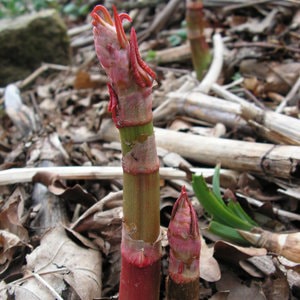 |
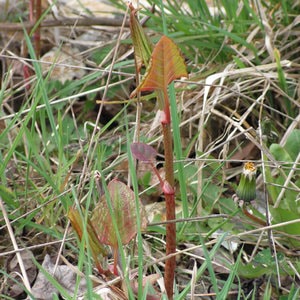 |
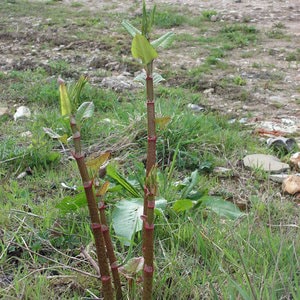 |
Japanese knotweed stems grow to 2-3 metres tall.
They're similar to bamboo with nodes and purple speckles and the leaves shoot out from the nodes in a zig-zag pattern.
The inside of the stem is hollow. At the mature stage, the stems are hollow and not woody and can be snapped easily to show their hollowness.
However, in the winter the stems become brittle, as can be seen from the images below.
| Stems are hollow | In winter brittle and sometimes collapse | The resemble bamboo canes |
|---|---|---|
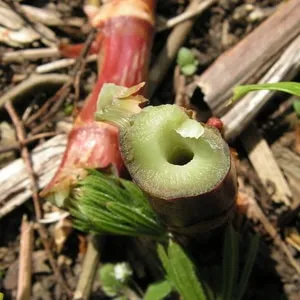 |
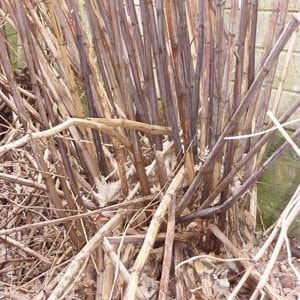 |
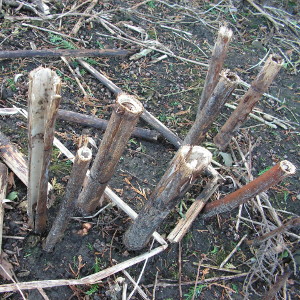 |
Now what to do?
The most important thing is not to spread the weed, which means no use of mechanical methods of cutting such as strimmers, hedge cutters, mowers or chain saws.
If you see or even think you see Japanese knotweed in a hedge along a road you should contact the local authorities and report it. It will be up to them to get it dealt with before it spreads, putting in place measures to ensure that the hedge isn’t cut in the mean time.
If you are going to cut Japanese Knotweed on your own property it is best to break it with your hands or use a manual pruners or clippers.
You should only cut the plant at the stem and ensure that you place the clippings on polythene or some other impenetrable surface.
Do not leave the clippings in the compost or on open ground!
You should bring the clippings to a registered landfill, letting management know that the clippings are knotweed or leave them on the polythene in a dry place and burn them in your fire once they’ve dried out.
The weed root can spread up to 23 feet away from the weed stem and up to 9.5 feet deep, so if you are excavating it you will need to clear a large area to ensure that you aren’t leaving any roots behind, particularly if you are dealing with a large infestation.
For this reason a lot of people prefer to use chemical action against the knotweed.
The option a lot of people suggest is Round Up Biactive or other Glyphosate based weed killer to kill the root.
If you decide to use a glyphosate based killer, you should wait to use it later in the year when the knotweed is in full bloom, as this is when it will be most effective.
When spraying you will need to start in the middle of the growth and work your way backwards out of the stems so as to avoid getting chemical on your clothes. It is advised that you cover as much of the leaves as you can, getting product onto the underside of the leaves if possible.
However no matter when you spray or how much of the leaves you cover, you will watch the area in successive years and spray any new growth as one spraying will not kill the weed completely.
The growth will not be as prevalent the following year but if it is not treated it won’t take long for the knotweed to take over once more. It is advised to inspect the area every year until no trace of re-growth is seen.
Another option to deal with knotweed is Garlon Ultra or a similar Triclopyr based product.
Some believe that this achieves a better kill rate of the knotweed and is licensed for use on Japanese Knotweed.
This is the best option if you are hoping to get rid of the plant in early spring, as it is more effective at this time.
It is easier to spray the knotweed when there is less leaf cover and the new growth is easier accessed.
As with the Round Up it is best to cover the leaves on both sides for maximum kill.
Unfortunately due to the resilient nature of Knotweed you will also need to keep an eye out in subsequent years for any re-growth as there is likely to be some that will need to be sprayed again.
If you have an infestation near a water course it is best to call in the experts. Some products are licensed for use near water course but some, such as the Garlon Ultra, are not.
Any that are licensed have to be used in smaller quantities than when used on open ground. The best way to deal with Knotweed along a water course is direct injection of the product into the stem for maximum kill and limited chance of pollution.
However this requires specialist tools and knowledge and it could be very costly to get wrong.
It is a tricky line to tread if you aren’t fully aware of the regulations and the last thing you want is to be facing fines and court actions for getting it wrong.
Calling the professionals might be more costly but when you’re dealing with cross compliance measures it could end up being a lot cheaper that having your payments revoked.
So hopefully you are now prepared to recognise your enemy.
Keep your eyes peeled for knotweed lurking on your land and know what your options are if you spot any.
Here’s hoping you get away without any of the hassle Japanese Knotweed brings.
RGA










